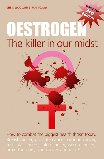Fastest growing area of lung cancer caused by oestrogen, not smoking
Non-small cell lung cancer has risen from 12 per cent of all lung cancer to 40 per cent in the last 20 or so years in America. And it is controlled by oestrogen (estrogen) receptors, in much the same way most breast cancers are.
The first clues came in a Canadian study covered in Cancer Watch about 5 years ago, where the growing area of lung cancer was amongst non-smokers and particularly younger women. An inconvenient truth for the cancer charities and health authorities who want to tell you it’s your fault because you smoke!
There are differences between lung cancer in women, and lung cancer in men. And, it is now known that lung cancer cells have oestrogen receptors. An evaluation of research to date in America has shown that women with more children have less risk of lung cancer, women who have an early menopause have greater risk of lung cancer, and women who have taken HRT have a 60% increased risk of dying from lung cancer whether or not they smoke. Conversely, women who have a diet high in phytoestrogens (plant oestrogens) have a lowered risk of lung cancer. And men may be protected by their oestrogen receptor sites.
Fat is broken down by Aromatase enzymes that convert it to oestrogen. And aromatase inhibitors have been studies for both breast cancer and lung cancer. Oestrogen is known, not just to be causal, but to encourage metastases too. Treatment with cisplatin, and exemestane has been shown to reduce progression. The oestrogen receptor pathway seems linked to developments connected with the epidermal growth factor receptor pathway. Erlotinib (Tarceva) is a drug used to treat this pathway.
Under normal conditions in women, there is a feed back system between the hormones progesterone and oestrogen. Each limits the other. But increasingly it is being found that chemical oestrogens (synthetic xenoestrogens) by pass this system and act unchecked. Just small levels, in parts per trillion, have been shown to cause osetrogenic effects.
Only recently the World Health Organisation recommended that Governments banned these ‘gender bender chemicals, like BPA and phthalates. But there are many such chemicals of concern and they have been linked to cancer and non-cancer issues (such as earlier periods, lowered sperm counts, enlarged prostates and endometriosis for example).
Read more on this subject; and on what you can do naturally to limit oestrogen in your life read ‘Oestrogen – the killer in our midst’ by Chris Woollams. Click here to read more.

Read more on lung cancer by clicking here.
References:
Diana C. Márquez-Garbán, Hsiao-Wang Chen, Lee Goodglick, Michael C. Fishbein, and Richard J. Pietras, Ann N Y Acad Sci. 2009 February; 1155: 194–205.
FischerBM, Pappot H. Oestrogen receptors in males associated with better survival. http://www.ncbi.nlm.nih.gov/pubmed/17905466
Chlebowski, R. et al. Lung Cancer Among Postmenopausal Women Treated With Estrogen Alone in the Women’s Health Initiative Randomized Trial. Journal of the National Cancer Institute. 2010 Aug 13
Chlebowski, R. et al. Oestrogen plus progestin and lung cancer in postmenopausal women (Women’s Health Initiative trial): a post-hoc analysis of randomized controlled trial. Lancet. 2009. 374(9697):1243-51.
Dahabreh, I. et al. Parity and risk of lung cancer in women: Systematic review and meta-analysis of epidemiological studies. Lung Cancer. doi: 10.1016/j.lungcan.2011.10.014. Published online December 12, 2011.
Hammoud, Z. et al. Estrogen promotes tumor progression in a genetically defined mouse model of lung adenocarcinoma. Endocrine-Related Cancer. 2008. 15(2):475-83.
Koushik, A. et al. Characteristics of menstruation and pregnancy and the risk of lung cancer in women.International Journal of Cancer. 2009. 125(10):2428-33.
Meinhold, C. et al. Reproductive and hormonal factors and the risk of non-small cell lung cancer. International Journal of Cancer. 2011. 128(6):1404-13.
Pesatori, A. et al. Hormone use and risk for lung cancer: a pooled analysis from the International Lung Cancer Consortium (ILCCO). British Journal of Cancer. 2013 Sep 3.
Pesatori, A. et al. Reproductive and hormonal factors and risk of lung cancer: The EAGLE Study.International Journal of Cancer. 2012 Nov 6. (Epub ahead of print)
Rodriquez, C. et al. Postmenopausal hormone therapy and lung cancer risk in the cancer prevention study II nutrition cohort. Cancer Epidemiology Biomarkers and Prevention. 2008. 17(3):655-60.
Seow, A. et al. Reproductive variables, soy intake, and lung cancer risk among nonsmoking women in the Singapore Chinese Health Study. Cancer Epidemiology Biomarkers and Prevention. 2009. 18(3):821-7.
Shimazu, T. et al. Isoflavone intake and risk of lung cancer: a prospective cohort study in Japan. American Journal of Clinical Nutrition. 2010. 91(3):722-8.
Siegfried, J. Early changes in pulmonary gene expression following tobacco exposure shed light on the role of estrogen metabolism in lung carcinogenesis. Cancer Prevention Research (Philadelphia, Pa). 2010. 3(6):692-5.
Slatore, C. et al. Lung cancer and hormone replacement therapy: association in the vitamins and lifestyle study. Journal of Clinical Oncology. 2010. 28(9):1540-6.
Yao, Y. et al. Hormone replacement therapy in females can decrease the risk of lung cancer: a meta-analysis. PLoS One. 2013. 14(8):e71236.